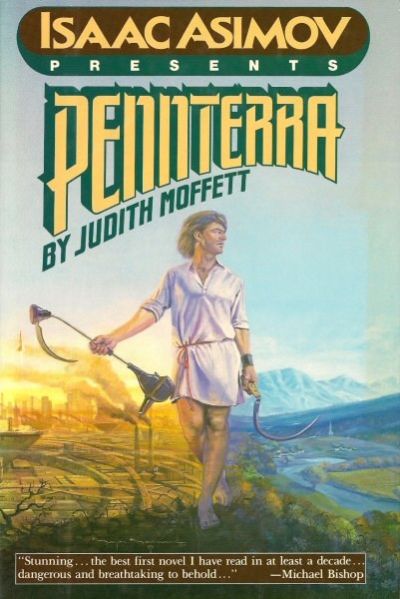A Piece of Fertile Ground
Pennterra
By Judith Moffett

5 Aug, 2019
Judith Moffett’s 1987 debut Pennterra is a standalone science fiction novel.
The world of Pennterra might have been the safe haven humanity will need once the destruction of Earth is complete, all but for one problem: it has natives.
Providentially, the first human colony on the planet was composed of Quakers. Rather than simply push the low-tech hrossa aside to take their land for humanity, the Quakers agreed to a list of onerous conditions. No use of high technology, zero population growth, and no expanding beyond the boundaries of the valley that the Quakers renamed Delaware. All of this was inconvenient, but the alternatives were fight the hrossa or head back to Earth. The Quakers agreed to the hrossa terms. Thus far the arrangement has worked and there is no reason it could not continue working for the indefinite future1.
The second human ship to arrive is the Down Plus Six. The Sixers are not Quakers and they are not inclined to follow the Quaker lead. Even if relocating the hrossa is a task for the future, the Sixers most definitely aren’t going to forgo high technology in their quest to carve a new home for themselves. Soon, there is a rapidly expanding Terran-style town on Pennterra.
The Quakers enjoy cordial relations with the nearest hrossa, in particular with a hrossa named KliUrrh. KliUrrh profoundly disapproves of the decisions the Sixers have made; he is sure that they will suffer for them. His god TuwukhKawan will surely take whatever steps are needed to end the affront to the planet.
KliUrrh’s faith might be simple superstition. But … the hrossa are far more familiar with their world than are the humans. The ecology seems similar to Earth’s at first glance, but closer examination reveals a number of curious facts, not least of which is the way that each species observes the same mandate for zero population growth that was imposed on the Quakers. They also sacrifice themselves as needed for the greater good of the ecosystem. The system clicks along like a well-maintained machine, but with no engineer in sight.
There is a simple way to test who is right, faith-bound hrossa (and their Quaker clients) or the Sixers: simply wait to see whether the humans wash across Pennterra as they did on ruined Earth, or if some physical manifestation crushes their unrealistic dreams.
It’s an experiment best observed from a distance.
~oOo~
Essayist Noel Perrin described Pennterra as the only Quaker SF work of which he was aware, from which I deduce he never encountered Joan Slonczewski’s Still Forms on Foxfield. There are a number of parallels between the two books:
-
both involve Quakers on an alien world;
-
both communities gave the new world a name referencing a famous Quaker; both involve enigmatic alien races;
-
both involve a fear the Earth might destroy itself (overstated in Slonczewski’s case);
-
and both tell what happens when more mainstream humans arrive to claim the seemingly defenceless alien world for their own.
A major difference: Slonczewski’s aliens deliver a sharp rebuke, whereas Pennterra discourages the human infection with a consequence less obvious but more damning.
It’s been decades since I reread this. Memory is an odd thing; I remembered the ecological bits. but not the wall-to-wall sex of pretty much every variety that occurs once a party of humans falls within the hrossa empathic fields. Indeed, this is much like the larger relationship between humans and the Penterran ecosystem: Penterra dominates and the humans must obey.
There’s a particularly vexing subplot involving a young Sixer girl named Caddie Birtwistle, who is sexually abused by her father, rescued thanks to the intervention of a Quaker boy, only to die a miserable (and in retrospect, avoidable) death on a journey that goes sour. It seemed to me that she had been singled out, victimized, and killed off to suit some obscure narrative purpose.
I liked the parts of the book I remembered: the puzzle of the ecology and the question of just how the Sixers would be rebuked (there’s never any real question, of course, that a giant boot would not eventually descend from the sky onto hubristic humans.). The parts I forgot, I forgot for a reason.
Pennterra is available here (Amazon), here (Amazon.ca), and here (Chapters-Indigo).
1: For as long as it takes for the first sufficiently large calamity to wipe out the settlement. There are six hundred Quakers, all living in one small valley. Any species with that population and range on Earth would count as endangered. But then … if the planet has accepted them, perhaps it will also make sure that they don’t die out.
